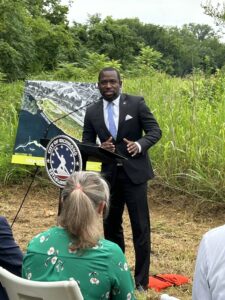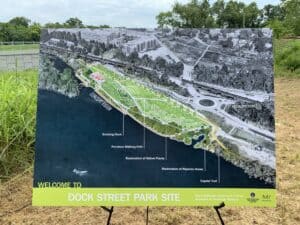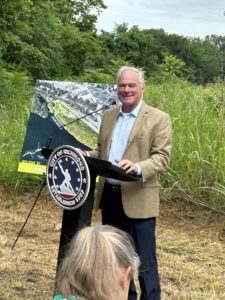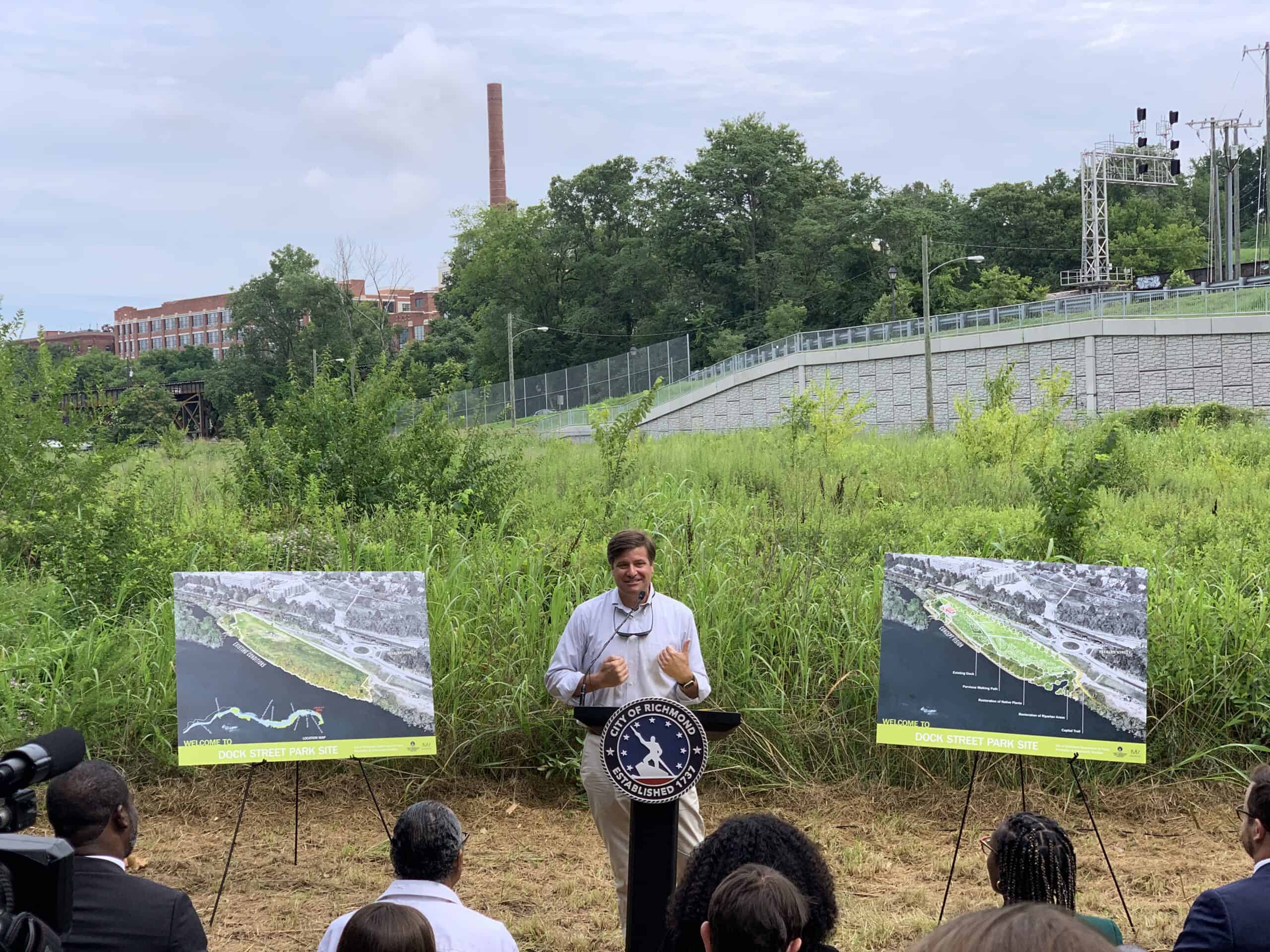RICHMOND, VA — The Conservation Fund, Capital Region Land Conservancy and City of Richmond announced today the permanent protection of four acres in Virginia’s capital city, completing a cooperative and yearslong effort to conserve what historians call “the view that named Richmond.”
Beyond maintaining water quality and opening new public access, efforts to protect the property on Dock Street preserve a view that inspired Richmond’s naming. In 1737, William Byrd II looked out over the James River from Libby Hill and noticed the view was strikingly similar to that along the Thames in Richmond, England. A century later in 1851, the City of Richmond purchased approximately five acres at Libby Hill, securing public access to this historic view and simultaneously establishing one of the jurisdiction’s first municipal parks. Protecting the Dock Street property ensures this historic viewshed remains unobstructed for future generations.

“I am proud to announce the protection of over four acres of Richmond’s breathtaking and historic riverfront,” said Richmond Mayor Levar Stoney. “Our commitment to the James River Park System is clear. We are going to ensure future generations can enjoy the historic riverfront and protect and improve our natural resources.”
Permanent conservation of the Dock Street property grants new public access to the riverfront along the Captain John Smith Chesapeake National Historic Trail, where the center of Richmond’s significant maritime commerce was once anchored. Moreover, the property represents the last link of the Virginia Capital Trail, a 51-mile trek connecting Richmond to Williamsburg, and allows the final piece of the trail to be moved off the busy city street and onto the waterfront.
“Today together we make history working collaboratively with many partners to acquire over four acres of riverfront spaces along the James River. Through adding this to our park system we will protect this space for future generations to enjoy,” said Chris Frelke, director of the Department of Parks, Recreation and Community Facilities. “Our green spaces are sacred to Richmond — these are the places that offer healing and where community is forged. And it is with the community the city will determine what this space will look like in the near future.”

Additionally, protection of the property will help to maintain water quality, benefiting both humans and wildlife. By keeping the Dock Street property free from commercial development, the land’s ability to naturally filter runoff and prevent additional sediment from reaching the river is preserved. Much as this benefits the 2.6 million people who live in the 10,000-square-mile James River watershed and rely on the river for their drinking water, a variety of species living in and around the river similarly prosper, such as Atlantic sturgeon, smallmouth bass and bald eagles.
“The phrase ‘small but mighty’ comes to mind for me when I think about the Dock Street property,” said Heather Richards, the Fund’s Mid-Atlantic regional director. “In just a handful of acres we hold a critical part of Richmond’s history, the key to completing a beautiful trail network and the future of clean water for this area. This is the kind of work The Conservation Fund loves to do — buying land to ensure its permanent protection and then passing it forward to its new caretakers — and it was a pleasure to work with the city and so many other amazing partners to get this done.”
“The Virginia Department of Conservation and Recreation is proud to support our partners in making the vision for such a significant open space project in Richmond come to life,” said DCR Director Matthew Wells. “As co-holder of the conservation easement on the adjacent Great Shiplock Park and other portions of Richmond’s James River Park, we are glad that this joint effort will improve public access to outdoor recreation opportunities — including an important connection to the Virginia Capital Trail.”
“Capital Region Land Conservancy’s founding is tied to co-holding the conservation easement on the James River Park System, with expansion of the park and public access to the riverfront as an ongoing essential part of its work,” said L. Preston Bryant, Jr., president of the Capital Region Land Conservancy. “In taking the lead in preparing due diligence, negotiating a contract, securing the necessary partnerships and raising significant funding for this effort, CRLC has again delivered an incredible asset to the residents and visitors of Richmond.”
Funding for conservation of the Dock Street property came in part from the National Park Services’ State and Local Assistance Program via the federal Land and Water Conservation Fund (LWCF), Virginia Land Conservation Foundation, Virginia Outdoors Foundation’s Preservation Trust Fund and private fundraising. A conservation easement co-held by the Capital Region Land Conservancy and Virginia Department of Conservation and Recreation was recorded on the property when The Conservation Fund transferred it to the City of Richmond.
The federal LWCF was fully and permanently funded by the Great American Outdoors Act in 2020. LWCF is a bipartisan program that conserves ecologically and economically valuable land across the United States, including many of Virginia’s iconic natural places, and is strongly supported by Virginia’s federal congressional delegation representing Richmond: U.S. Senator Mark Warner, U.S. Senator Tim Kaine and U.S. Representative Jennifer McClellan. In total, Virginia has received more than $76 million in LWCF assistance that has made more than 400 projects possible.
“I’ve been proud to support the federal Land and Water Conservation Fund for years, and I have been thrilled to see the numerous projects that we have been able to support thanks to this program,” said U.S. Senator Mark Warner. “The historic Dock Street property is yet another example of the LWCF being used to support our communities, protect Virginia’s rich history, and preserve our natural lands.”

“Like most Richmonders, so many of my fondest memories were made along the James River,” said U.S. Senator Tim Kaine. “The permanent protection of the Dock Street property is an exciting milestone that will help to both preserve the James and ensure that Virginians can continue to experience the river’s beauty for generations to come. I’m proud to have helped pass the Great American Outdoors Act that provided the funding needed for this effort — and for over 400 important conservation projects in Virginia — and will continue to do all that I can to protect the natural treasures that make Virginia so special.”
“The protection of the Dock Street property preserves an important piece of our Commonwealth’s history and ensures current and future generations can enjoy this incredible site on the Virginia riverfront,” said U.S. Representative Jennifer McClellan. “While in the General Assembly, I passed a resolution to celebrate the beauty and historic importance of this viewshed of the James River over a decade ago, and I am thrilled that it will now be permanently protected. Preservation of the Dock Street property, made possible through dedicated coordination between local, state and federal entities, will help maintain our natural resources and complete the Virginia Capital Trail. It’s a win-win for the environment and local residents, and it represents an important step in improving public accessibility to outdoor areas for all Virginians. I commend all the leaders and organizations who helped make this possible.”
Previously conserved at an earlier stage was roughly one acre of adjacent land to establish a new river center for environmental education. The center, operated by the James River Association, will focus on connecting Richmond youth with river-based, hands-on learning experiences. Ground was broken for that facility — the James A. Buzzard River Education Center — in May.
About The Conservation Fund
At The Conservation Fund, we make conservation work for America. By creating solutions that make environmental and economic sense, we are redefining conservation to demonstrate its essential role in our future prosperity. Top-ranked for efficiency and effectiveness, we have worked in all 50 states since 1985 to protect nearly 9 million acres of land, including over 85,000 acres in Virginia. conservationfund.org
About the City of Richmond Department of Parks, Recreation and Community Facilities
The City of Richmond Department of Parks, Recreation and Community Facilities provides recreation and leisure programs to enhance the quality of life for citizens and visitors to the City of Richmond. The department maintains over 700 acres of parkland that includes the James River Park System, pocket parks, community centers, and athletic fields.
About Capital Region Land Conservancy (CRLC)
Incorporated in March 2005 as a non-profit 501(c)(3) organization, CRLC seeks to conserve and protect the natural and historic land and water resources of Virginia’s Capital Region for the benefit of current and future generations. www.capitalregionland.org
Media contacts:
Joshua Lynsen, The Conservation Fund, 301-675-7764, jlynsen@conservationfund.org
Tamara Jenkins, City of Richmond, 804-646-1087, Tamara.Jenkins@rva.gov
Parker Agelasto, Capital Region Land Conservancy, 202-302-0153, parker@capitalregionland.org

